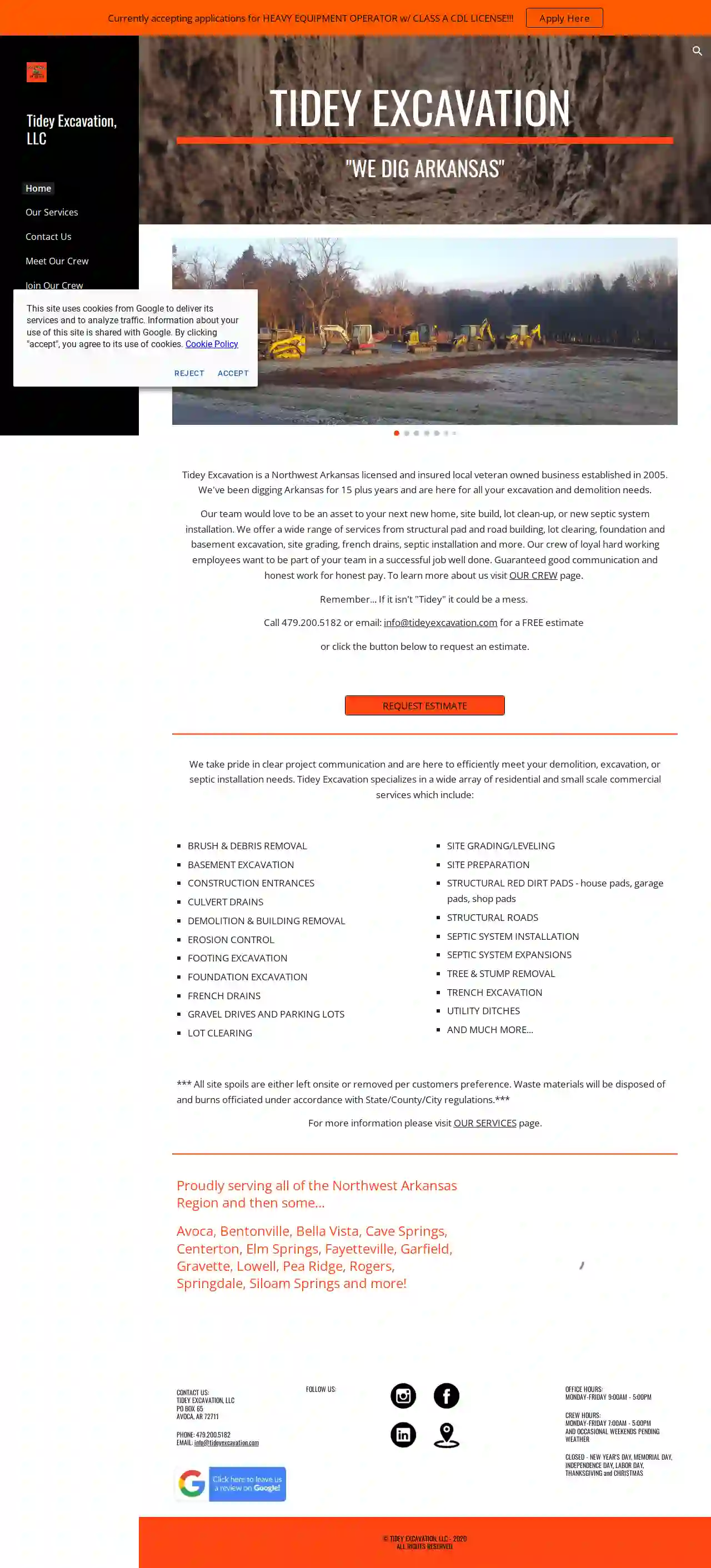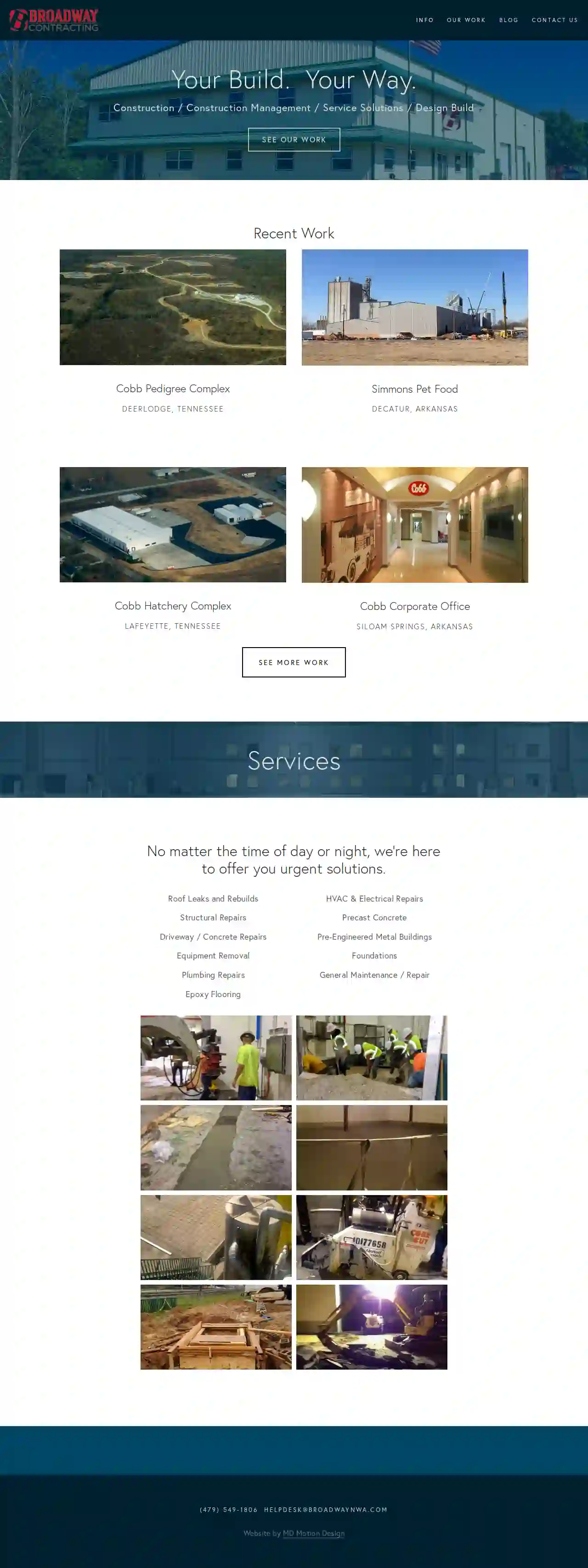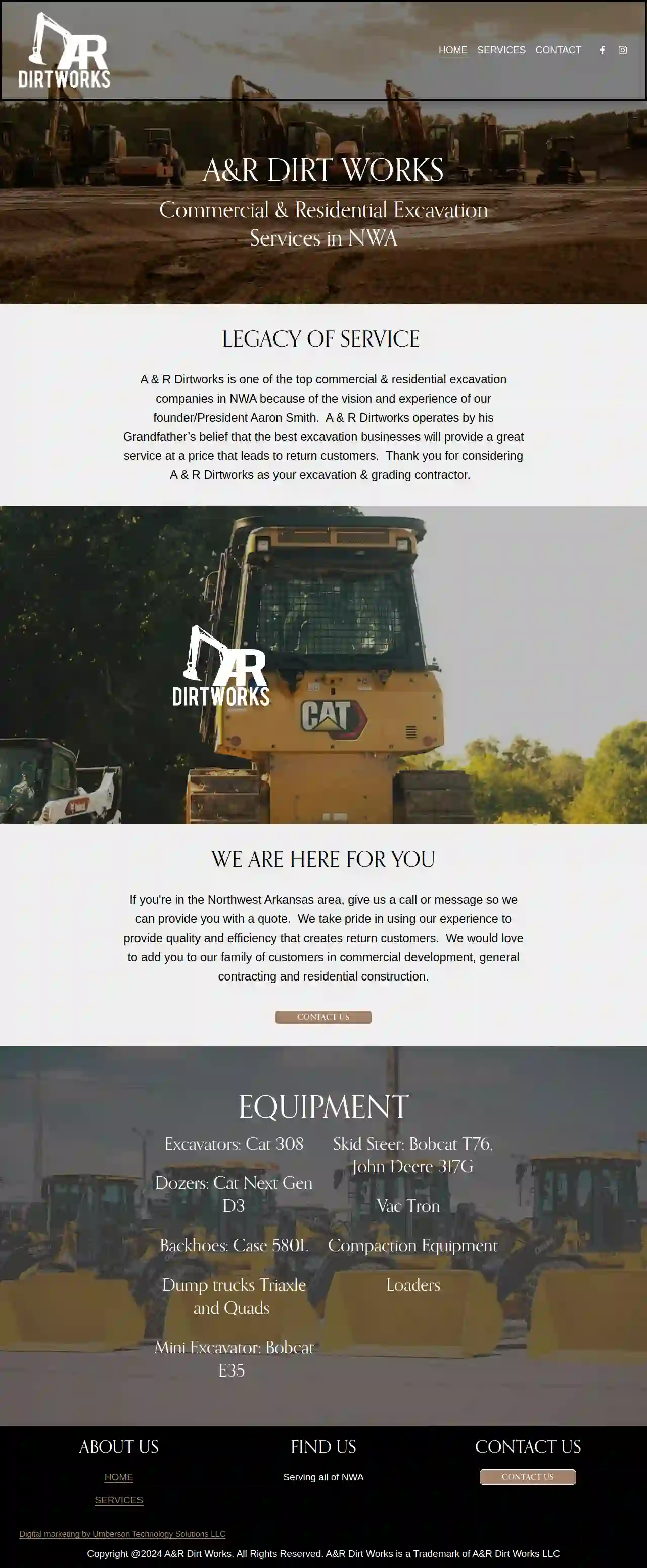Demolition Contractors Centerton
Find Demo Contractors in Centerton
Get multiple Demo Contractor quotes for your project today! Compare profiles, reviews, accreditations, portfolio, etc... and choose the best service.

Tidey Excavation, LLC
4.812 reviewsPO BOX 65, Avoca, 72711, USTidey Excavation, LLC "WE DIG ARKANSAS" Tidey Excavation is a Northwest Arkansas licensed and insured local veteran owned business established in 2005. We've been digging Arkansas for 15 plus years and are here for all your excavation and demolition needs. Our team would love to be an asset to your next new home, site build, lot clean-up, or new septic system installation. We offer a wide range of services from structural pad and road building, lot clearing, foundation and basement excavation, site grading, french drains, septic installation and more. Our crew of loyal hard working employees want to be part of your team in a successful job well done. Guaranteed good communication and honest work for honest pay. To learn more about us visit OUR CREW page. Remember... If it isn't "Tidey" it could be a mess.
- Services
- Why Us?
- Gallery
Get Quote
Broadway Contracting, LLC
56 reviewsRogers, USBroadway Construction Broadway Construction is a full-service construction company serving Northwest Arkansas and beyond. We offer a wide range of services, including construction management, design-build, and service solutions. We are committed to providing our clients with the highest quality workmanship and customer service. We are also committed to safety and sustainability. We are proud to be a part of the Northwest Arkansas community and we are committed to giving back. We are a family-owned and operated business with over 20 years of experience in the construction industry. We have a team of experienced professionals who are dedicated to providing our clients with the best possible experience. We are committed to building lasting relationships with our clients and we are proud to be a part of their success. We are committed to providing our clients with the highest quality workmanship and customer service. We are also committed to safety and sustainability. We are proud to be a part of the Northwest Arkansas community and we are committed to giving back. We are a family-owned and operated business with over 20 years of experience in the construction industry. We have a team of experienced professionals who are dedicated to providing our clients with the best possible experience. We are committed to building lasting relationships with our clients and we are proud to be a part of their success.
- Services
- Why Us?
- Gallery
Get Quote
AR Excavation & Land Clearing
517 reviewsRogers, USAR Excavation & Land Clearing: Your Trusted Partner for Excavation and Land Development in Northeast Arkansas AR Excavation & Land Clearing is a family-owned and operated excavation and land development company based in Jonesboro, Arkansas. We've been serving both residential and commercial clients in Northeast Arkansas since 2018, bringing over 15 years of industry experience to every project. Our commitment to quality, expertise, and customer satisfaction is what drives our success and growth. Why Choose AR Excavation & Land Clearing? Family-Owned and Operated: We treat every project as if it were our own, ensuring personalized service and attention to detail. Extensive Experience: With over 15 years in the industry, our team brings a wealth of knowledge and expertise to every job. Comprehensive Services: From dirt work to land development, we have the equipment and skills necessary to handle all your excavation needs. Local Expertise: Serving Jonesboro, Arkansas, and the surrounding Northeast Arkansas rural areas, we understand the unique challenges and requirements of the local landscape.
- Services
- Why Us?
- Gallery
Get Quote
Davco Dirtworx LLC
59 reviews8629 Panorama Rd., Rogers, 72758, USWelcome to Davco Dirtworx - Your Premier Excavation Company in Northwest Arkansas. We specialize in providing top-notch excavation services for residential and commercial projects alike. Our team of experienced operators and dedicated staff are committed to delivering exceptional results, ensuring your project is completed on time and within budget. Discover the Davco Dirtworx difference today! Let's Start Digging Specializing in Site Development Expert Site Development Services at Davco Dirtworx! We specialize in grading, land clearing, and utility installation for a seamless construction experience. Our extensive background in the construction sector enables us to manage projects of all sizes and complexities. Trust Davco Dirtworx for your small residential projects or large commercial developments, as our knowledgeable team and cutting-edge equipment ensure success every step of the way. Learn More Comprehensive Pre-Construction Services In addition to our excavation and site development services, Davco Dirtworx also offers pre-construction services to help you plan your project effectively. Our team will work closely with you to develop a comprehensive plan, identify potential challenges, and provide solutions to ensure a smooth construction process. Our pre-construction services will set your project up for success, from obtaining permits to creating accurate cost estimates. Learn More
- Services
- Why Us?
- Testimonials
- Gallery
Get Quote
Hoffman Trucking & Excavation
51 reviewsLowell, USAbout Us For large and small excavation projects, Hoffman Trucking & Excavation has a comprehensive fleet of excavators and machinery to ensure that the job is carried out reliably, professionally and at a competitive price. The top-rated excavating contractor in Lowell, AR, we take pride in providing quality results by diligently carrying out our duties. Family owned and operated, we are rooted in deep values. You can expect great communication, customer service and timely delivery when you hire our team. We offer a wide range of services including excavation, , site clearing, land and construction demolition services, shoring and Bobcat services. We also offer grading, regrading, resloping, building and land site preparation, land clearing, tree removal and tree root removal. You can count on Hoffman Trucking & Excavation for excellent results. We have the skills and tools to be the best excavating contractor for your Lowell, AR project. Call us today and get a free estimate. Mission Statement Our mission is to provide the best customer service, with integrity and by paying attention to the details that matter most to you.
- Services
- Why Us?
- Testimonials
- Gallery
Get Quote
GNG Underground
57 reviewsRogers, USWelcome to GNG Underground Professional Excavation, Utility Trenching, and Landscaping Services for Northwest Arkansas Safety & Quality Service, Always our Priority Serving all of Northwest Arkansas Welcome to GNG Underground, providing experienced excavation and landscaping services for NWA GNG is a Veteran-Owned excavation company, based in Bella Vista and serving all of Northwest Arkansas GNG Underground is a multi-faceted excavating and landscaping company in Northwest Arkansas. From clearing land for your new project to installing storm shelters and septic tanks and propane tanks, GNG has you covered. We are your go-to outdoor utility company. We take pride in the quality of our work and the projects we complete for our clients. We offer a wide variety of outdoor excavation services in Northwest Arkansas so that when you need something done on your property, you know that you can call the trusted excavators at GNG Underground.
- Services
- Why Us?
- Gallery
Get Quote
Lukas Excavation and Demolishing
53 reviewsHot Springs, USAbout Us Licensed And Insured We are a State Licensed Excavation Contractor in Arkansas and Professionally Insured which puts us into the seat of responsibility and requires professionalism for every job we do. Prompt and Reliable We follow Arkansas State Laws and Industry Guidelines as a Licensed Excavation Contractor to complete your job promptly and reliably. We check with all Arkansas underground utility service providers before we dig to assure safety to ourselves and our customers. Satisfaction Guaranteed We strive to do every job as if we were the customer so there is complete satisfaction when the job is done. We provide excavation services in Montgomery County, Yell County, Hot Springs County, Pulaski County, Polk County, Saline County, Garland County, Pike County, Arkansas, Hot Springs, Hot Springs Village, Little Rock, North Little Rock, Malvern, Sims, Story, Mt. Ida, Mena, Russellville, Benton, Bryant, Bismarck, Maulmelle, Sherwood, Booneville, Danville, Searcy, Conway, Pine Bluff, Sheridan and many other cities within Arkansas.
- Services
- Why Us?
- Gallery
Get Quote
A & R Dirtworks
52 reviewsRogers, USA&R DIRT WORKS Commercial & Residential Excavation Services in NWA LEGACY OF SERVICE A & R Dirtworks is one of the top commercial & residential excavation companies in NWA because of the vision and experience of our founder/President Aaron Smith. A & R Dirtworks operates by his Grandfather’s belief that the best excavation businesses will provide a great service at a price that leads to return customers. Thank you for considering A & R Dirtworks as your excavation & grading contractor. “We take pride in our work and strive to make every customer part of the family and life long customers” — Aaron Smith - Owner
- Services
- Why Us?
- Gallery
Get Quote
Wegner Crystal Mines
4.7543 reviews82 Wegner Ranch Road, Mount Ida, 71957, USOUR STORY In 1978 I, Richard J. Wegner, discovered the alluring beauty of the Ouachita Mountains in west central Arkansas. The attraction was so great that I began searching for a new home in the Spring of 1979; after the heavy snow in northern Illinois began to melt. After searching for a month, I narrowed my search to the area surrounding Lake Ouachita - a jewel in the mountains. Soon, by word of mouth I located a couple hundred acres nestled in a boxed-in valley. After seeing the virtually undeveloped property, I knew I was home. By the summer I was constructing a log cabin home and other buildings to start up what I thought would be a horticultural business. One day I discovered broken clear stones in my garden. Curious, I walked the property perimeter to familiarize myself with the land and it new potential. Soon I discovered several shallow trenches around the mountainside. Gleaming in the piles were small quartz crystals. They were everywhere and I felt a deep heartfelt connection to the earth and its glory at that time. I stayed at the site and quietly saw my calling laid out in front of me. My spirit was moved and my previous carefully laid plans were put aside and I began to follow my heart. A YOUNG RICHARD WEGNER AND MINERS AT THE PHANTOM MINE My time was spent studying geology and other earth sciences. I didn't consult with existing mining operators because I wished to create a venture based on my vision. In 1980 I started Wegner Enterprises, Inc. and Wegner Quartz Crystal Mines to begin the prospecting on my land and on government lands. The crystals began to emerge from the earth as I and my neighbor Randy hand dug in several areas on my land. Realizing the need for equipment to move the large rock, I leased a excavator; powerful & track mounted. We produced thousands of pounds of high quality clear crystals in a short time. I realized that finding a market entailed a global approach, so I attended the largest marketplace, the 1981 Tucson Gem & Mineral Shows. Once discovered, our crystals sold out in a few days, leaving a week to still sell with no product. I loved the thrill of mining the exquisite crystals, so it was time to expand and hire employees. By 1983 I employed 30 full time workers and we took semi-trucks loaded with many tons of crystals to Tucson and still we sold almost everything except the truck. "Wow", I thought, "the world needs these gemstones" as they went all over the planet. UNCLEANED PHANTOM QUARTZ CRYSTAL CLUSTER At some point during all this success, I realized the importance of giving back to the community. I began to donate to the local food bank and to the local schools. I also started to hire local people to work at the mine. I wanted to create a business that was not only profitable, but also beneficial to the community. I believe that we have a responsibility to give back to the community that supports us. I am proud of the fact that we have been able to create jobs and support local charities. I am also proud of the fact that we have been able to preserve the natural beauty of the Ouachita Mountains. I believe that we have a responsibility to protect the environment for future generations. I am committed to sustainable mining practices that minimize our impact on the environment. I am also committed to educating the public about the importance of conservation. I believe that we can all work together to create a better future for our planet.
- Services
- Why Us?
- Testimonials
- Gallery
Get Quote
Laser Level Dirt Works
544 reviews2810 S Arkansas Ave, Russellville, 72802, USCall Today For Expert Excavation & Land Clearing Services Proudly Serving Arkansas River Valley Taking Precision to the Next Level! Laser Level Dirt Works is a locally owned and operated business specializing in excavation and land clearing services. We are committed to providing our clients with the highest quality work and customer service. We use state-of-the-art equipment and techniques to ensure that every job is completed to perfection. We are proud to serve the Arkansas River Valley and surrounding areas. Why Choose Us? State of the Art Equipment We use high-tech, laser-guided equipment to perfectly grade your property. Quality The quality of our work is unmatched! We pay close attention to detail to ensure every job is completed to perfection. Owner Operated Our owner personally answers every call and oversees each job to ensure every project to completed correctly and on time. Customer Satisfaction Guaranteed We take pride in upholding our reputation and making sure every customer is fully satisfied with our work. Our reviews speak for themselves!
- Services
- Why Us?
- Gallery
Get Quote
Over 22,076+ Excavation Companies on our platform
Our excavation companies operate in Centerton & surrounding areas!
ExcavationHQ has curated and vetted the Best Excavation Businesses near Centerton. Find a top & trustworthy contractor today.